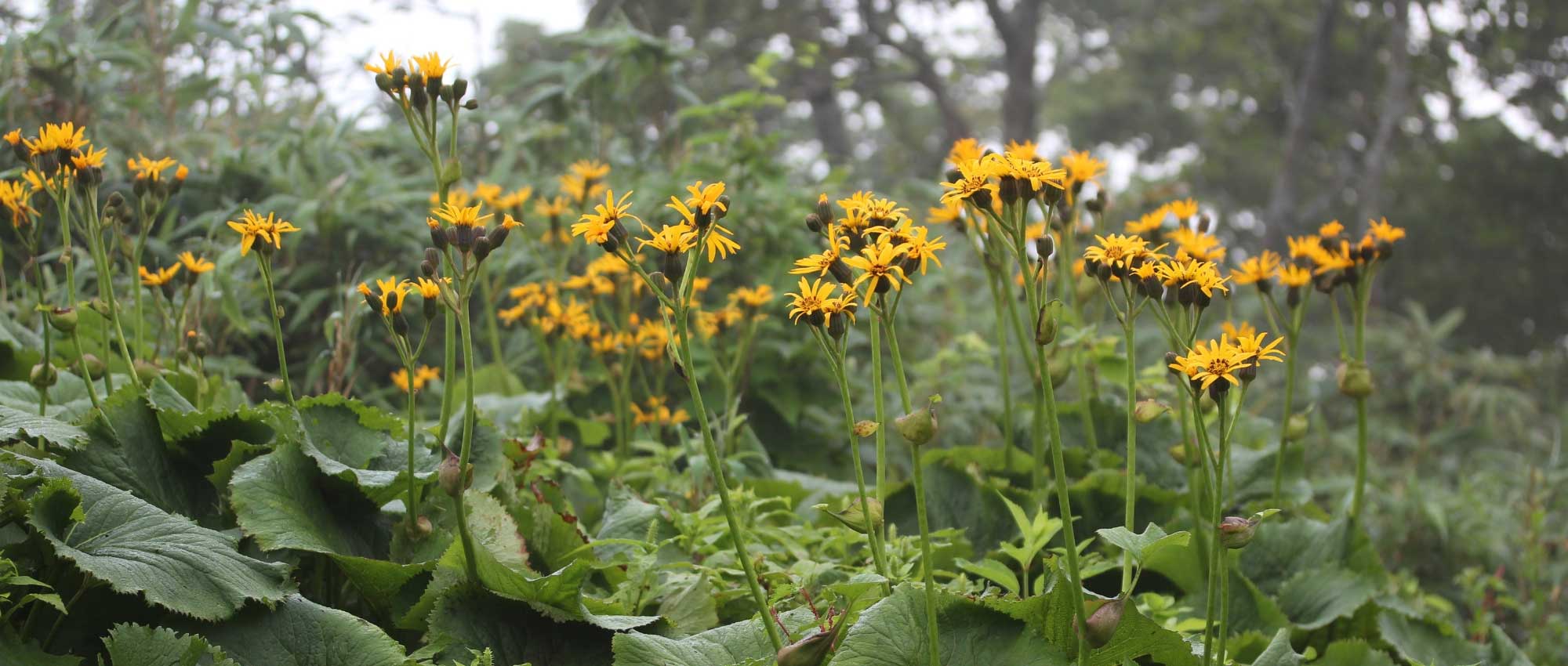
Ligularia (leopard plant) : planting, growing and care
Contents
Ligularias in a nutshell
- Ligularias produce bright, vivid yellow flowering!
- Their foliage is abundant, very decorative, green or purple in colour
- These large perennials have a striking, lush appearance
- They are well suited to heavy, clay soils
- They are fairly easy to grow, robust and hardy
- Ligularia is indispensable in shady gardens!
A word from our Expert
Ligularias are large perennials offering generous, lush foliage and very bright summer flowering. Flowers are gathered in heads (as with daisies), which themselves are grouped into upright, long, slender bunches or clusters. Thanks to their superb foliage, ligularias are highly decorative even when not in flower! The foliage is quite graphic, rounded or palmate in shape, sometimes deeply cut. It turns a dark green or purple colour, ideal for setting off golden-yellow flowering!
The most commonly grown are Ligularia stenocephala, including the superb variety ‘The Rocket’, as well as Ligularia przewalskii and Ligularia dentata. These species mainly come from Asia and impress with their large yellow inflorescences, in bunches or spikes. In France, in the wild, there is Siberian ligularia, Ligularia sibirica, but this is less common in cultivation.
Ligularias are an excellent solution for shady corners of the garden and for heavy, clayey, wet soils… where most plants do not thrive! These perennials dislike drought and are perfect at pond edges. They are vigorous, robust plants, rather easy to grow. In summary, with ligularia it’s best to avoid hot, dry situations… otherwise it will need regular watering!
Botany
Botanical data
- Latin name Ligularia sp.
- Family Asteraceae
- Common name Ligularia, leopard plant
- Flowering between July and September–October
- Height between 1 and 2 m
- Exposure shade, partial shade, or non-scorching sun
- Soil type fresh to moist, humus-bearing, deep
- Hardiness between -15 and -30 °C
Ligularia are herbaceous perennial plants, comprising about 150 species, mostly from eastern and central Asia. Many occur in China, as well as Japan and Siberia. They grow there on damp, marshy soils, by waterways and in woodland. A few species occur in Europe. In France, in the wild, only Ligularia sibirica is found, mainly in the Massif Central.
Ligularia belong to the large family Asteraceae, like daisies, oxeye daisies, sunflowers and asters. These plants are notable for bearing flowers gathered in heads! What appears to be a single flower is actually a multitude of tiny, reduced flowers, usually tubulate florets in the centre and ligulate florets on the outside. Asteraceae correspond to the former family Compositae.
The genus Farfugium (for example Farfugium japonicum) is very close to Ligularia! These perennials also bear large, rounded leaves and heads of yellow flowers. Ligularia are also close to senecios (Ligularia tangutica is a synonym of Senecio tangutica).
Ligularia comes from the Latin ligula: ligule, referring to the shape of the small outer florets of the head, fine and elongated.
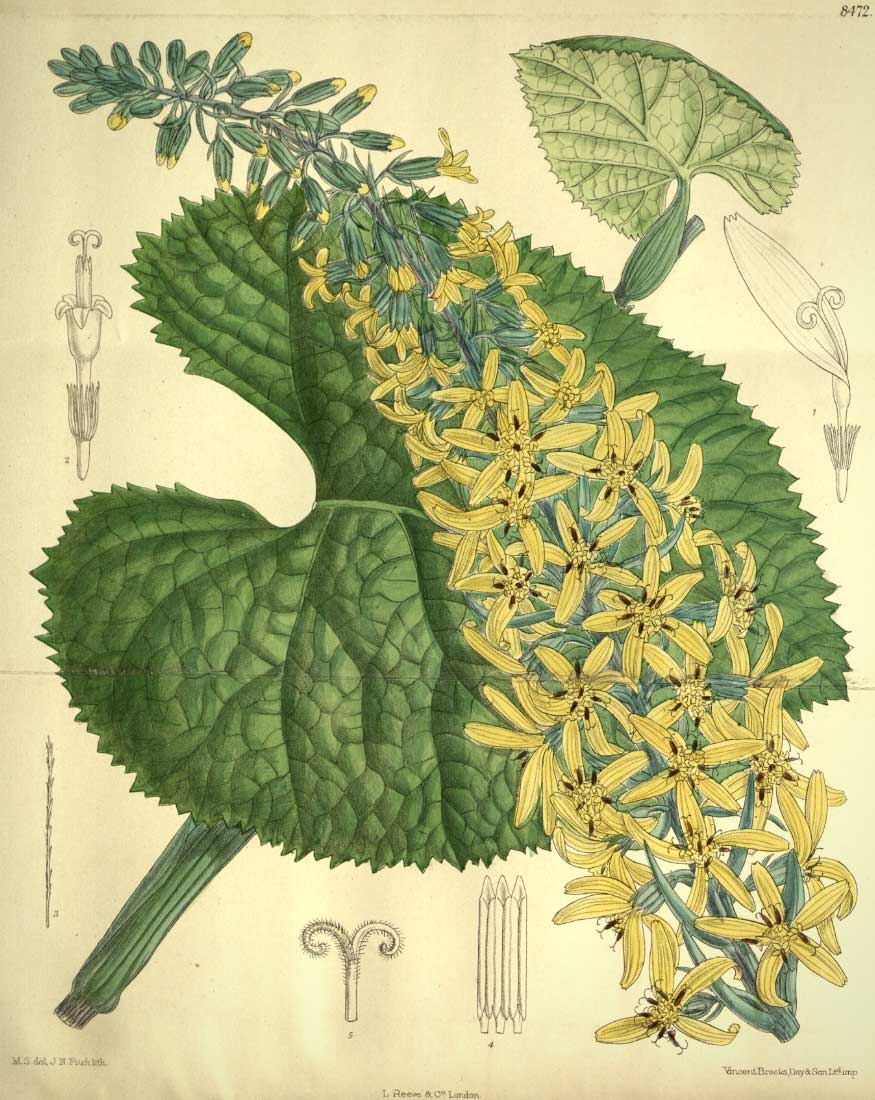
Ligularia stenocephala: botanical illustration
Ligularia are large plants that can reach up to 2 m in height! They form broad clumps, but can take several years, generally three, to reach full development and really bulk up.
Flowering of Ligularia takes place from July through to September–October.
They then produce heads of flowers, as seen in oxeye daisies, daisies or asters! A head looks like a single flower but actually comprises a profusion of tiny, rudimentary flowers. Central florets are tubulate (tube-shaped), outer florets are ligulate.
The flowers are yellow, sometimes orange. They bring brightness to the garden—especially as they are mainly planted in understory, shaded areas. The centre of the heads is yellow or brown, generally darker than the outer florets.
Flowers are often borne on darker stems. These can be black or very dark (as in Ligularia stenocephala ‘The Rocket’), providing a striking contrast and adding graphic interest!
In summer, Ligularia inflorescences rise above the foliage. They can take two very different forms, depending on variety! Thus, they may be very airy, with erect, long, thin clusters bearing countless small flowers (as in Ligularia przewalskii), giving a fairly vaporous aspect. Flowering can also be compact and low, offering a few large heads carried close to the foliage (Ligularia dentata). In this case, flowers are gathered not in clusters but in flattened bouquets (corymbs).
Ligularia are melliferous, much appreciated by bees and butterflies.

Flowering of Ligularia dentata (photo Krzysztof Ziarnek) / Detail of a head of Ligularia dentata (photo Bff) / Erect, fine clusters of Ligularia przewalskii (photo Kor!An)
Ligularia produce impressive foliage, which alone makes the plant very decorative, even when not in flower! It is generous, ample and very large, and can reach up to 35 cm in length. Leaves are rather rounded in shape and are generally cordate at the base. They can also be palmate. Veins are strongly marked, giving the leaf a more or less puckered appearance. The edge of the lamina is generally dentate, more or less deeply so.
Because Ligularia have dense, ample foliage, weeds struggle to grow… which reduces weeding!
Foliage is massive, imposing… except in some species, which display deeply divided leaves, such as Ligularia tangutica!
Leaves are borne on a long petiole, generally darker than the lamina.
Ligularia have large basal leaves, cordate or triangular, often dentate; and cauline leaves (inserted on the stems), smaller. The latter are alternate, arranged one after the other. They become progressively smaller towards the top of the stems.
Leaves are often dark green, but can also be purple, with varying shades. The variety ‘Pandora’ seems to have the darkest foliage, almost black-purple. When foliage is dark, it provides a remarkable contrast with the golden-yellow flowering, setting it off perfectly! Leaf colour can also change over time. It is quite common for leaves to be purple at first, then turn green. In Ligularia dentata ‘Desdemona’, leaves become green on the upper side but remain purple beneath.
Ligularia foliage is deciduous. It dies back in autumn and reappears in spring.

Foliage of Ligularia stenocephala (photo Salicyna) / Reverse of a leaf of Ligularia dentata ‘Desdemona’ (photo Bff) / Divided foliage of Ligularia przewalskii (photo Salicyna)
Ligularia have deep roots, allowing them to draw water from deep in the soil.
Fruits are elongated, dark achenes, topped by a small egret. The whole fruiting forms small plumed spheres, as in dandelions. Seeds are carried on the wind, enabling the plant to disperse and establish elsewhere. You can harvest them, but sowing is fairly tricky to succeed.
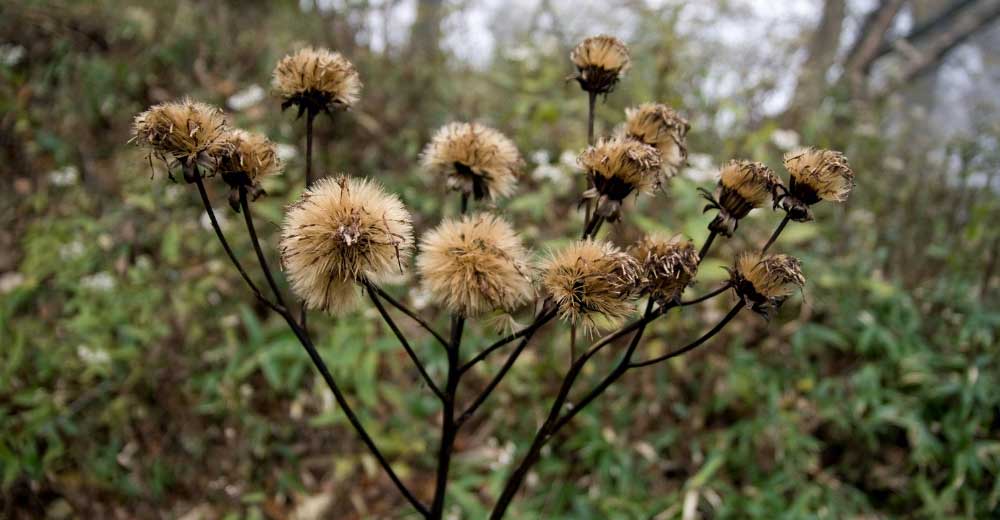
Fruits (achenes) of Ligularia dentata (photo Σ64)
Main ligularia varieties

Ligularia stenocephala The Rocket - Leopard Plant
- Flowering time July to October
- Height at maturity 1,80 m
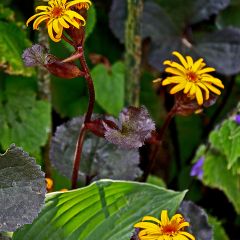
Ligularia dentata Britt-Marie Crawford - Leopard Plant
- Flowering time August to October
- Height at maturity 1 m
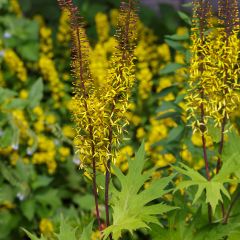
Ligularia przewalskii - Leopard Plant
- Flowering time July, August
- Height at maturity 70 cm

Ligularia dentata Desdemona - Leopard Plant
- Flowering time August to October
- Height at maturity 1 m

Ligularia Gregynog Gold - Leopard Plant
- Flowering time September to November
- Height at maturity 1,80 m
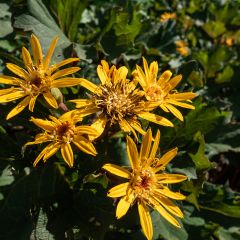
Ligularia Osiris Cafe Noir - Leopard Plant
- Flowering time August, September
- Height at maturity 50 cm
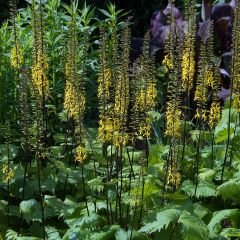
Ligularia stenocephala - Leopard Plant
- Flowering time July to October
- Height at maturity 1,80 m
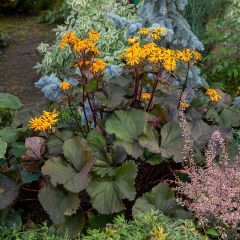
Ligularia dentata - Leopard Plant
- Flowering time August to November
- Height at maturity 1,50 m
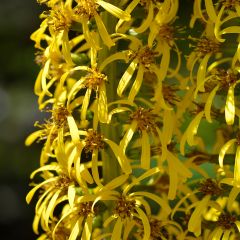
Ligularia wilsoniana - Leopard Plant
- Flowering time August to October
- Height at maturity 2 m
Discover other Ligularia
View all →Available in 1 sizes
Available in 2 sizes
Available in 1 sizes
Available in 1 sizes
Available in 1 sizes
Available in 2 sizes
Available in 1 sizes
Available in 1 sizes
Available in 1 sizes
Available in 1 sizes
Planting
Where to plant?
Ligularia is a woodland plant that prefers partial shade or shade. However, it tolerates sun provided the soil remains cool… But avoid scorching sun, which can damage the foliage. In any case, the more Ligularia are exposed to sun, the more frequent watering they will need! Conversely, under too-dense shade, flowering may be less abundant, and varieties with purple foliage can tend to revert to a dark green tone…
Ligularia thrives in cool, even moist soils. Ideally, soil that does not dry out in summer. It is perfect for dressing the edges of ponds and watercourses, alongside other bankside plants!
Plant Ligularia preferably sheltered from wind. Indeed, as these are fairly tall plants, strong winds could break the stems!
Unlike many plants, Ligularia grows well in heavy, clay soils. It also favours ground rich in organic matter and deep. We recommend adding some well-rotted compost. Ideally, a forest-type soil, as found in woodlands: rich, cool, humus-bearing, deep…!
Ligularia is a plant that spreads, so allow sufficient space around it. Moreover, as it is a large perennial that appreciates cool, deep soils, it is not suitable for container cultivation.
When to plant?
You can plant Ligularia in autumn (September–October), or in spring, around April.
How to plant?
Ligularia are imposing, fairly large perennials. To allow them to develop well, leave at least 60 cm between two young plants, even up to 1 m.
- Dig a hole wide and deep enough.
- We recommend adding some well-rotted compost to enrich the soil.
- Then remove the plant from its pot and place it in the planting hole.
- Backfill with soil all around.
- Firm down to ensure good contact between soil and roots, and to avoid air pockets.
- Water generously.
We suggest then applying a mulch at its base, made of ramial chipped wood (BRF) or dead leaves.
Continue to water regularly after planting until the plant is well established.
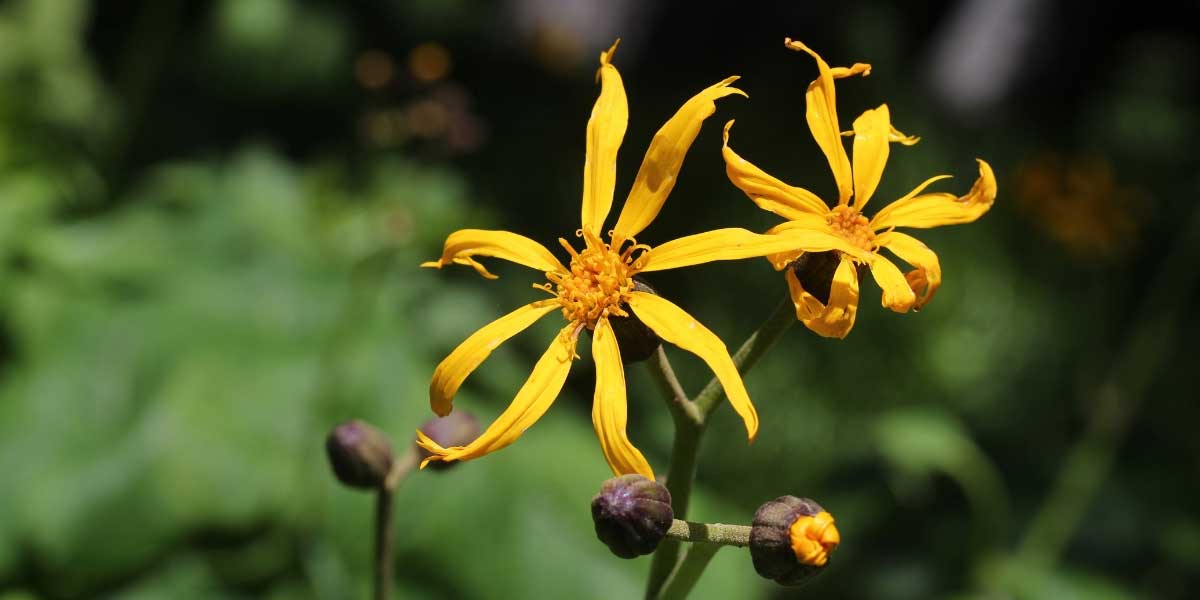
Ligularia dentata (photo Alpsdake)
Care
If Ligularias have been planted in a location suited to them (for example in cool soil, under dappled shade…), they will require very little maintenance.
We recommend adding well-rotted compost. You can incorporate it into the soil by lightly forking it in at the surface. Also consider applying a mulch layer about 5 cm thick to help keep soil cool. Ligularia needs the earth to stay cool or even moist… Don’t hesitate to water in periods of drought!
You can divide clumps from time to time (about every three years) to rejuvenate them. Likewise, for appearance and to relieve the plant, after flowering you can remove faded flower stems. Taller plants may also need staking if exposed to winds.
Ligularia is a hardy, robust plant and is not particularly prone to disease. Its main enemies are gastropods: slugs and snails like to nibble young leaves and shoots while still tender.
In heat and sun the plant may wilt during the day… But generally it will recover by evening once coolness returns. Otherwise, don’t hesitate to give it some water. Foliage can also sometimes be sunburnt if the plant is placed in too sunny a spot.
Multiplication: Division
Ligularias are preferably propagated by division, easier and quicker than sowing.
Division of clumps
Division of ligularias is best carried out in early spring, or in autumn (after flowering). We recommend doing this every three years. As well as producing new young plants, division has the advantage of rejuvenating clumps and encouraging their growth. Avoid working on very hot days.
- Lift a clump, keeping as many roots as possible.
- Remove excess soil to make the root system clearly visible.
- Divide the clump into several sections, using a knife if necessary. Ensure each section has roots.
- Replant them immediately in a new location, after preparing the soil.
- Water generously.
Pairing Ligularia in the garden
As ligularias prefer rather moist soil, they are perfect on pond edges! You can plant them with the luxuriant foliage of ferns and Gunneras, pair them with the yellow flowering of Iris pseudacorus, or with the pink spikes of loosestrife… You can also add Japanese irises and Asian primulas! Feel free to combine them with Lysimachia, whose flowering is similar and which also appreciate fresh soil.
Ligularias are ideal in woodland shade gardens! Place them alongside other plants such as hostas, Tricyrtis, brunneras, or Geranium nodosum, and of course ferns. To add some colour, you can include foxgloves. You will create a cool, shaded, very natural feel!
Discover our collection of shade-loving perennials and 5 ideas for pairing with ligularias

Ligularias can be part of a very natural scene, for example at the edge of a pond, in partial shade. Here, Gunnera manicata (photo Tom Oates), Matteuccia struthiopteris (photo Chmee2), Ligularia przewalskii (photo Kor!An), Filipendula ulmaria (photo Algirdas) and Lysimachia punctata (photo AfroBrazilian)
Feel free to pair ligularias with other decorative foliage for a beautiful shady scene: heucheras, ferns, rodgersia, Hakonechloa, lady’s mantles, Persicaria ‘Red Dragon’… You will achieve a lush-looking garden! Ligularias go wonderfully with the variegated foliage of hostas! You can also combine them with Carex (for example, Carex morrowii or Carex oshimensis ‘Evergold’…). Among ferns, we recommend osmundas and Matteuccia struthiopteris, which have a majestic, impressive aspect. Also, because ligularias have very large, substantial leaves, they create a lovely contrast of form with the lighter, finely divided fronds of ferns!
You can also incorporate ligularias into a mixed bed or border with other summer-flowering perennials: daylilies, rudbeckias, astilbes, platycodons, campanulas… If there is enough sun, add some grasses, such as pennisetums, to lighten the bed and bring movement. Also discover Veronicastrum, with superb, upright flower spikes that add strong structure. If your bed receives more sun, consider watering occasionally if needed.
Finally, as ligularias are imposing plants that form large clumps, they can also be planted as specimens, which really showcases them.
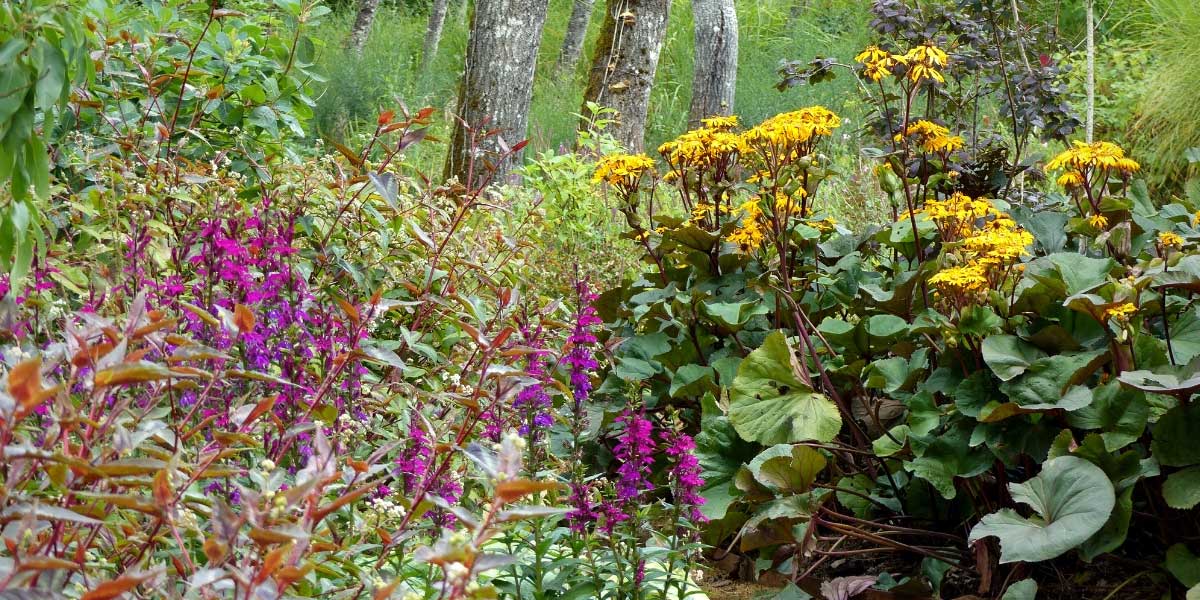
Ligularia dentata ‘Britt Marie Crawford’, Lobelia speciosa ‘Tania’ and Persicaria ‘Red Dragon’
Useful resources
- Discover our range of Ligularia!
- Browse our guide to choose a Ligularia
- To pair Ligularia, you can choose from other shade-loving perennials
- Discover Farfugium too, plants very similar to Ligularia!
Frequently asked questions
-
Foliage is full of holes and looks nibbled! Why?
Look no further... Ligularias have few enemies, apart from slugs and snails! Gastropods are especially fond of their young shoots and leaves. You can make a slug trap or scatter sawdust or ash around your young plants to deter them. If that isn't enough, use slug pellets.
- Subscribe!
- Contents


































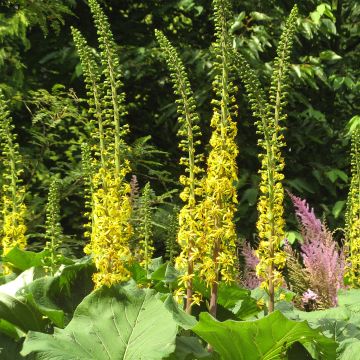


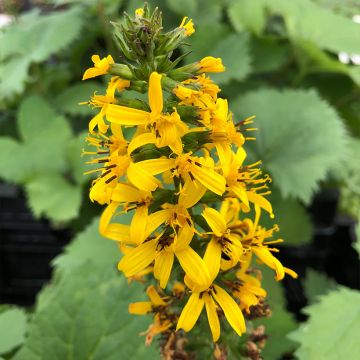

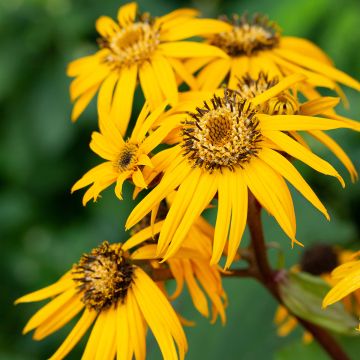


Comments